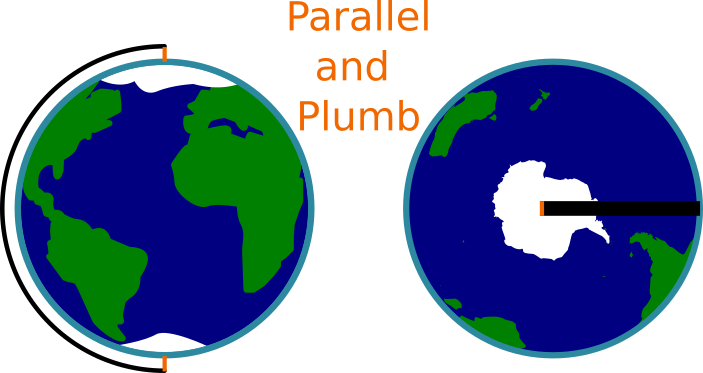Aparently, I’ve conflated Level with Plumb, the walls cannot be parallel and plumb. Due to the curve, the center of gravity for the walls would require them to angle in slightly together or not be plumb.
When your walls are level, you have a problem. Usually you want your walls to be plumb.
As a
pediatricpedantic but fun point, in surveying, level lines are defined to follow the Earth’s curvature. This means they are technically not straight. Horizonal lines, which are perpendicular to plumb lines, are often used as approximations for level lines.Generally it’s safe to use them interchangeably, but sometimes the distinction is important.
https://theconstructor.org/surveying/terms-in-leveling-uses/20077?amp=1

Did you mean pedantic?
Lol gotta love autocorrect 🤣
@eating3645 @sin_free_for_00_days The inventor should have a special place reserved in hell.
To be fair, it saves me more often than it ducks me
Removed by mod
I figured this was a doctor with some kind of architectural hobby.
I guess you could put it on ever higher stilts to satisfy the parallel and level thing.
Not level, after a while the vector of gravity will not be normal to the floor.
to be fair, scientifically that is true for all buildings.
What a wild thing to think about. On one end of a straight building, it’s a slide. On the other, it’s a normal building. MindFuck
We do have examples of buildings needing to account for the curvature of the earth.
One that comes to mind is The fountain at the Christian Science Mother Church in Boston…
It’s about a quarter mile long and the water flows evenly over the granite curbs along its entire perimeter. If it didn’t follow the earth’s curvature the water would all just spill over at the middle.
Im very surprised that noone here has mentioned the LHC in CERN Headquarters, Geneva, Switzerland. The LHC or Large Hadron Collider is so huge that it stretches across 2 countries (France and Switzerland) and stretches over a circumference of an impressive 17 miles (27 kilometers). It is so large that when building it they not only had to take into consideration the curvature of the LHC tunnel, but also the curvature of the earth.
These are indeed some impressive buildings, but I believe we’d be remiss not to mention Long John, Pocono Raceway’s purported largest toilet facility in the world. At 1500 feet in length, it may well be the most overengineered outhouse on the planet.
I seem to recall that this has to be accounted for when designing the support towers on particularly long bridges. According to a quick Google search, the most extreme example is the Akashi-Kaikyō bridge in Japan. The support towers are almost 3.5 inches farther apart at the top than they are at the bottom.
Also FYI, the word “level” generally refers to things laying perfectly flat. The word “plumb” refers to thing standing perfectly upright, which is why some jokers in the comments are giving you a hard time, despite what you meant being fairly obvious.
You can. The middle of the room just needs to be slightly recessed into the ground. Honestly, building sites are leveled before construction begins and they deal with a lot more variation than you’d see from the curvature of the earth.
I can do it. Two walls: one on the north pole and one at the south pole would be parallel and plumb.

FYI level refers to horizontal (mostly, although horizontal is a perfectly straight line 90° from vertical at that location while level follows the curvature of the earth), plumb for vertical.
Removed by mod
The original post has nothing to do with the curvature of space time, or non-Euclidean geometry.
This only has to do with the fact that on a plane (e.g floor of a building, of literally any size), above a gravity source (here, we can treat the earth as a point source), the gravitational vector will only be perpendicular to the surface at a single point. All other points will experience gravity at an angle.
Removed by mod
Pretty sure they just level the ground though
The idea about the really long building though is that gravity pulls down at a different angle as you get further two points further apart Even if the pad was absolutely straight, If you had a 2 mi long building the walls would no longer be plumb* at the ends if they were parallel.
Edit* missed a letter
Relatedly, some long structures that seek entirely straight have different lengths depending on the altitude you measure them. For example, an oft repeated tidbit is that the Lake Ponchartrain causeway is two inches longer when measured at the deck than at water level due to the earths curvature.






